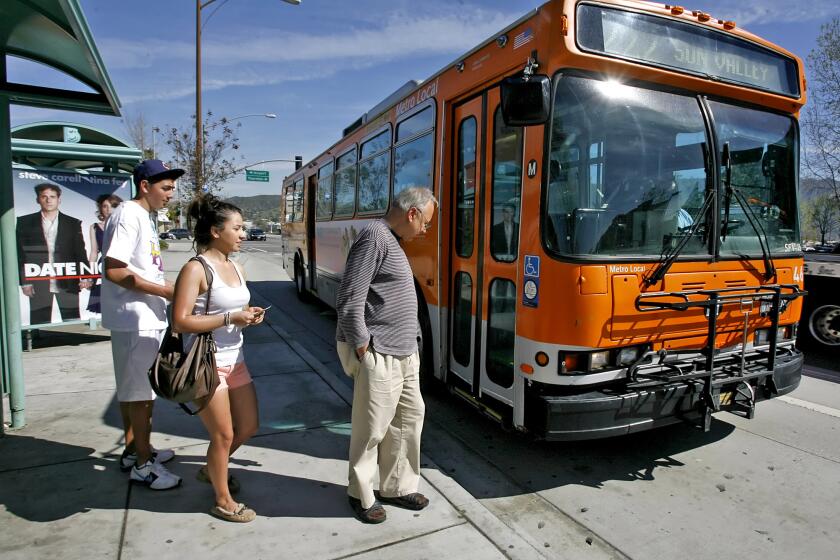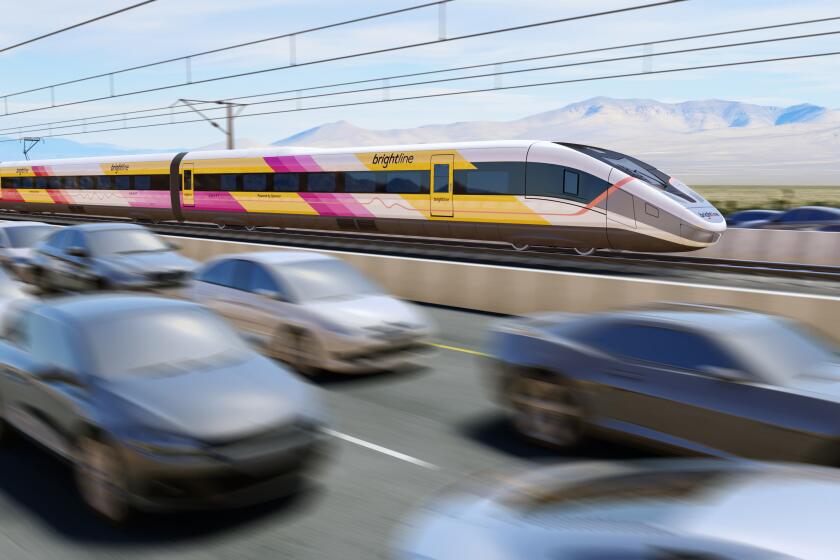PERSPECTIVE ON MASS TRANSIT : Invest in Buses--for the People : The MTA is expected to put the bulk of its budget in a rail system, which is backed by lobbyists and campaign contributions.
On Wednesday, at the monthly board meeting of the Metropolitan Transportation Authority, members are expected to adopt a budget that will fund overpriced, marginal and elitist rail projects at the expense of a bus-centered plan that could bring a first-rate public transit system to Los Angeles.
With an annual budget of $3.8 billion, MTA is about the last remaining local agency with enough money to do its job well. Until recently, this city’s “transit policy” has made Los Angeles the auto-dependence and smog capital of the United States. “Mass” transit was a class-biased, third-rate bus system for working people, people of color, the young, the old and the disabled, who, it was assumed, would stand on corners forever waiting for their buses to come in, without enough collective clout to change policy.
In recent years, however, concern about air quality, urban congestion and business infrastructure has led to increased funding through two county sales taxes and the federal Intermodal Surface Transportation Efficiency Act. So far, the tragic result is that the Los Angles County Transportation Commission--now the MTA--has placed most of its money on a few high-visibility rail projects. These projects--the Blue Line, Red Line, Green Line and Metrolink-- engender civic pride among the affluent while taking funds from the workhorse of urban transit, the bus system. Even at the present inadequate level of operation, buses make 30,000 stops in the county, covering more than 4,000 miles and serving 1.5 million riders per day. The rail system will have 250 stops covering 400 total miles and serving 500,000 people while requiring outrageous subsidies. (For example, Metrolink riders are subsidized at $38 per ride, compared with $1.17 for bus riders).
This year, after a great deal of public protest, the MTA board has agreed to fund increased bus service on 25 of its most overcrowded lines, throwing a bone to the transit-dependent, while arguing over the funding of the Pasadena extension of the Blue Line, an east-west line proposed for the San Fernando Valley and the completion of the Green Line from Norwalk to El Segundo--deals that will actually reduce overall transit service in the very communities engaged in boosterism for those rail lines.
The reason: There is no money for those lines without agreeing to cut back the bus system. As MTA chief Franklin White has pointed out, he inherited a budget with serious revenue shortfalls and greater rail system costs than projected. As each new rail line devours discretionary funding currently used for bus service, we’re likely to see, as early as next year, service reductions, fare increases, hiring freezes and gutting of the clean fuels program. This will perpetuate a cycle in which increased fares lead to a loss of ridership and fare-box revenues--the bus system has already lost 300,000 daily riders over the last nine years--because of fare increases.
The MTA board should adopt a motion mandating that $1.5 billion be spent each of the next 10 years to improve bus service, buy a new fleet of clean-fuel buses and build well-designed and safe bus stations that could reflect the “four pillars” strategy we have been proposing--ridership needs, environmental quality and energy efficiency, job development and community revitalization. Such a system would stand in stark contrast to the graffiti-marred, pollution-belching, crowded and dangerous adventure that now defines most people’s bus experience.
A first-class, bus-centered system could be a hub for new businesses. It could generate a job-development plan in which local manufacturers could create a high-wage, unionized, electric and alternative-fuel bus industry that could also expand into the electric-car market. It could help air quality and energy efficiency by providing far more buses, bus-only lanes on major thoroughfares as well as freeways and express buses on many routes now planned for rail. Spending $1.5 billion per year on a first-class bus system, instead of $967 million as proposed, would still take up less than 40% of the MTA budget.
Unfortunately, our experience is that, too often, the four pillars of a good transit plan are no match for the four C’s--contracts, contractors and campaign contributions. At past MTA budget meetings, the testimony of the Strategy Center, Concerned Citizens of South Central Los Angeles, El Rescate and Hotel and Restaurant Workers union have been drowned out by an army of rail lobbyists.
No wonder. Before Richard Riordan became both mayor and an MTA director, his law firm, Riordan and McKinzie, received fees to negotiate a land purchase for the Metrolink system. Riordan and other MTA board members also got campaign contributions from Tutor Saliba, the Parsons Corp., Morrison-Knudsen and ICF Kaiser, all major rail contractors. It is difficult to have a “public” debate about priorities when private interest and private gain too often shape the real agenda.
If the MTA does not guarantee the funding for a high-quality bus system, half-completed and underutilized rail lines will stand 10 years from now as monuments to public malfeasance, while most Angelenos will still drive their cars and a great opportunity for clean air and public transit will have been lost.
More to Read
Start your day right
Sign up for Essential California for news, features and recommendations from the L.A. Times and beyond in your inbox six days a week.
You may occasionally receive promotional content from the Los Angeles Times.






